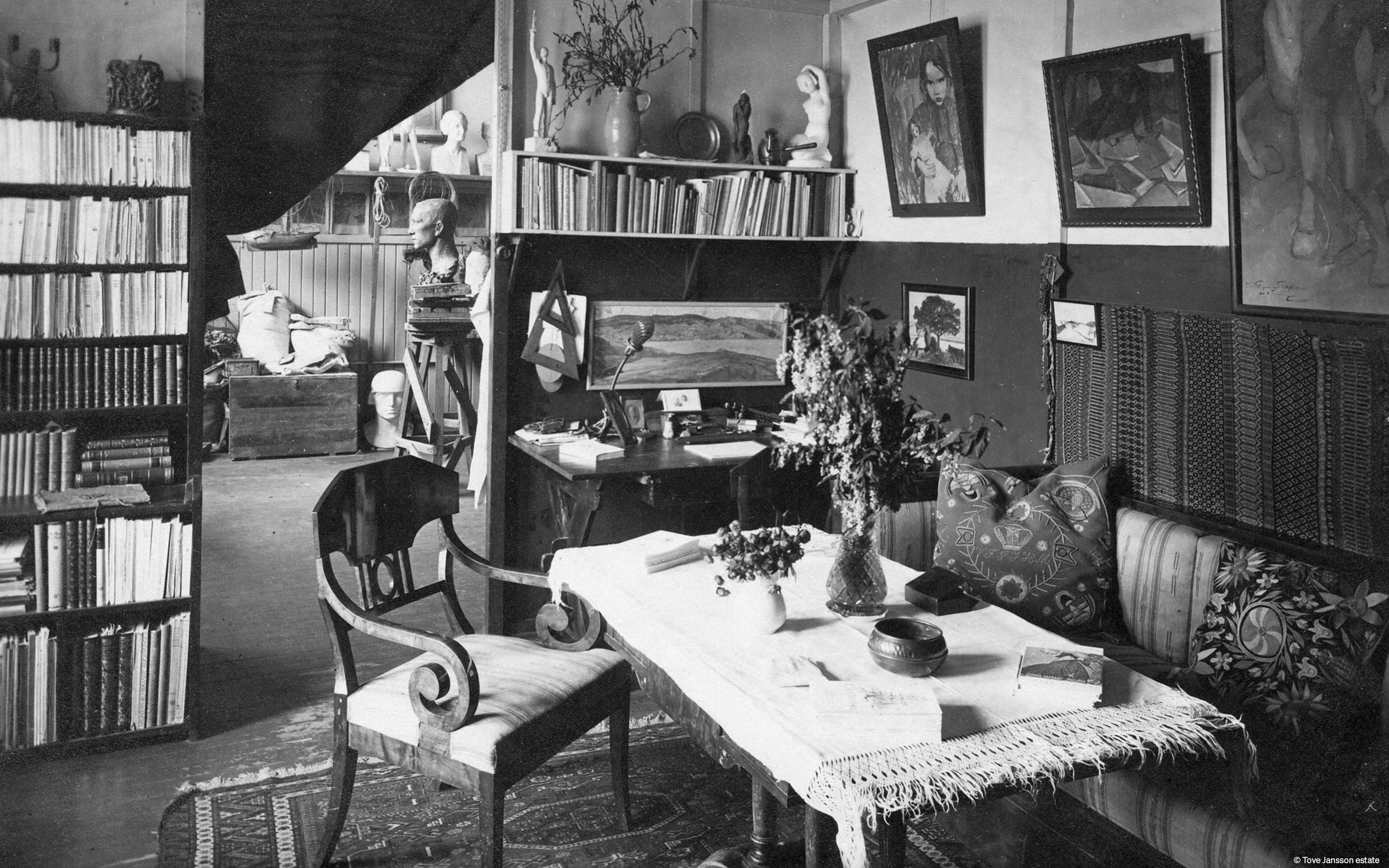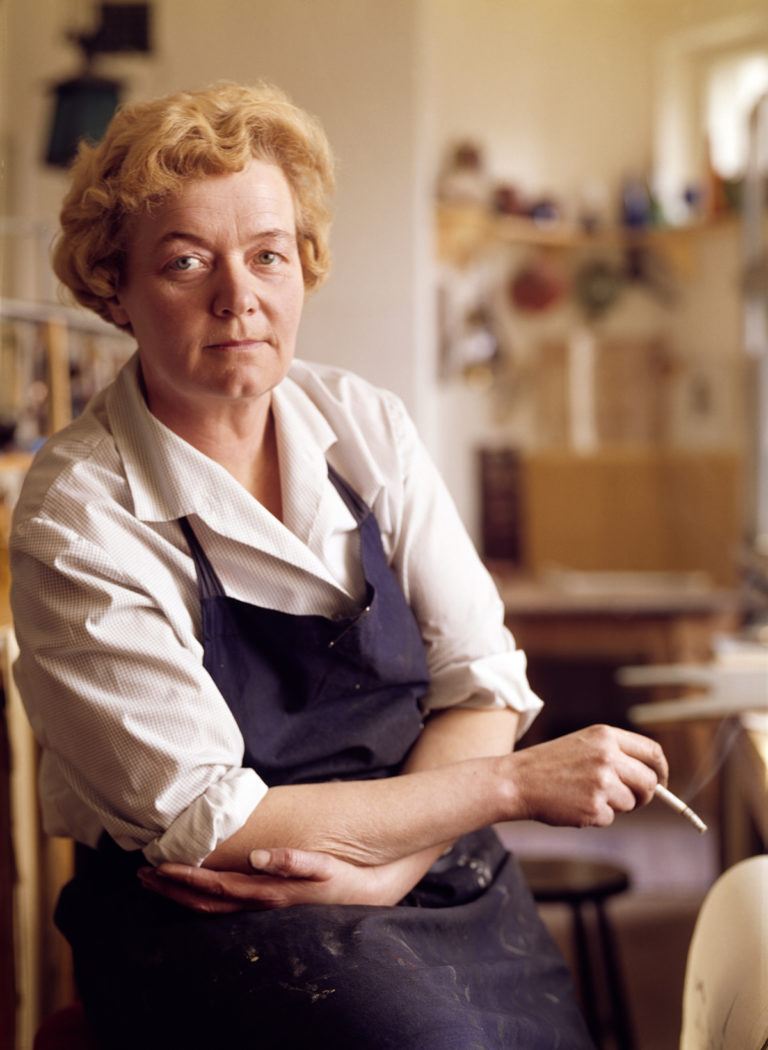Family with an open door
As a child, Tove Jansson sits on her mother Signe ‘Ham’ Hammarsten Jansson’s, lap while she designs banknotes and makes illustrations for magazines. The small family lives in an art nouveau house on Luotsikatu in Helsinki’s Katajanokka district.
To everyone’s surprise, Ham, brought up in Stockholm, has moved to a city where people speak Finnish, and she did so for love – for sculptor Viktor Jansson, ‘Faffan’, whom she met in Paris.
Ham is responsible for providing a regular source of income for the family. Together with her daughter, she poses on the cover of a feminist magazine, because it is unusual for a woman to be in control of the family economy.


Tove Jansson sits on her mother Signe Hammarsten Jansson’s, Ham’s, lap.
The 1910s is a decade of great change in Finland – a breeding ground for a nation and a language identity of its own. Even though the children grow up in the shadow of war, the atmosphere at the Jansson home is happy. The mother and child sit together in front of a stove, looking at the fire, and the mother tells a story that always begins in the same way:
‘Once upon a time there was a little girl who was terribly pretty and her mummy liked her so awfully much …’ (Sculptor’s Daughter 1968)
Tove Jansson is the oldest child in the Jansson family, which includes the parents, Tove, and her brothers Per Olov and Lars. The family’s culture is equally Finland–Swedish (a Swedish-speaking minority in Finland) and Swedish.
The siblings grow up with a strong belief that working as a professional artist is the obvious way to spend each day, and the meaning of existence.


Viktor Jansson and Signe Hammarsten Jansson met in Paris.


Signe Hammarsten Jansson with Tove on the cover of the magazine Astra in 1922.

 Tove Jansson drew and illustrated this story in 1921, when she was just seven years old.
Tove Jansson drew and illustrated this story in 1921, when she was just seven years old. Another family central to Tove Jansson live on the other side of the Gulf of Bothnia. At the age of sixteen, she moves to her uncle’s home in Stockholm to begin art studies at the Tekniska skolan (Technical School). She also makes lengthy visits to her grandparents, who live on the Swedish island of Blidö with their large family in a house with a big porch, surrounded by a flourishing garden. Tove Jansson’s uncles relish telling ghost stories, and, like Ham, are adventurous and full of life.
‘Once upon a time there was a little girl who was terribly pretty and her mummy liked her so awfully much …’
At the Technical School the adolescent Tove Jansson matures as an artist. She designs, draws croquis (figure sketches) and develops her love of colour. In her letters, she writes of amusing things but also about homesickness and the sense of responsibility she feels at the time. Tove Jansson has a strong desire to tell stories and create, but not everything is joyful. She wants to help Ham support their family. For Tove Jansson, it is natural to follow in her parents’ footsteps with their complete dedication to artistic work.
The family move into a newly established Lallukka Artists’ Home in Helsinki’s Töölö district and create a collective of their own. Ham assists Faffan in plaster casting; the brothers start writing, and the family members become each other’s critics. Ham shares her contacts with her daughter and helps her gain a foothold in the newspaper world. Faffan and his colleagues have parties that continue into the small hours.
The connection between livelihood and artistic work is clear from the start. Art is work, an attitude towards life, and a passion.
As a child, Tove Jansson sits on her mother Signe ‘Ham’ Hammarsten Jansson’s, lap while she designs banknotes and makes illustrations for magazines. The small family lives in an art nouveau house on Luotsikatu in Helsinki’s Katajanokka district.
To everyone’s surprise, Ham, brought up in Stockholm, has moved to a city where people speak Finnish, and she did so for love – for sculptor Viktor Jansson, ‘Faffan’, whom she met in Paris.
Ham is responsible for providing a regular source of income for the family. Together with her daughter, she poses on the cover of a feminist magazine, because it is unusual for a woman to be in control of the family economy.
The 1910s is a decade of great change in Finland – a breeding ground for a nation and a language identity of its own. Even though the children grow up in the shadow of war, the atmosphere at the Jansson home is happy. The mother and child sit together in front of a stove, looking at the fire, and the mother tells a story that always begins in the same way:
‘Once upon a time there was a little girl who was terribly pretty and her mummy liked her so awfully much …’ (Sculptor’s Daughter 1968)
Tove Jansson is the oldest child in the Jansson family, which includes the parents, Tove, and her brothers Per Olov and Lars. The family’s culture is equally Finland–Swedish (a Swedish-speaking minority in Finland) and Swedish.
The siblings grow up with a strong belief that working as a professional artist is the obvious way to spend each day, and the meaning of existence.
Another family central to Tove Jansson live on the other side of the Gulf of Bothnia. At the age of sixteen, she moves to her uncle’s home in Stockholm to begin art studies at the Tekniska skolan (Technical School). She also makes lengthy visits to her grandparents, who live on the Swedish island of Blidö with their large family in a house with a big porch, surrounded by a flourishing garden. Tove Jansson’s uncles relish telling ghost stories, and, like Ham, are adventurous and full of life.
‘Once upon a time there was a little girl who was terribly pretty and her mummy liked her so awfully much …’
At the Technical School the adolescent Tove Jansson matures as an artist. She designs, draws croquis (figure sketches) and develops her love of colour. In her letters, she writes of amusing things but also about homesickness and the sense of responsibility she feels at the time. Tove Jansson has a strong desire to tell stories and create, but not everything is joyful. She wants to help Ham support their family. For Tove Jansson, it is natural to follow in her parents’ footsteps with their complete dedication to artistic work.
The family move into a newly established Lallukka Artists’ Home in Helsinki’s Töölö district and create a collective of their own. Ham assists Faffan in plaster casting; the brothers start writing, and the family members become each other’s critics. Ham shares her contacts with her daughter and helps her gain a foothold in the newspaper world. Faffan and his colleagues have parties that continue into the small hours.
The connection between livelihood and artistic work is clear from the start. Art is work, an attitude towards life, and a passion.
























